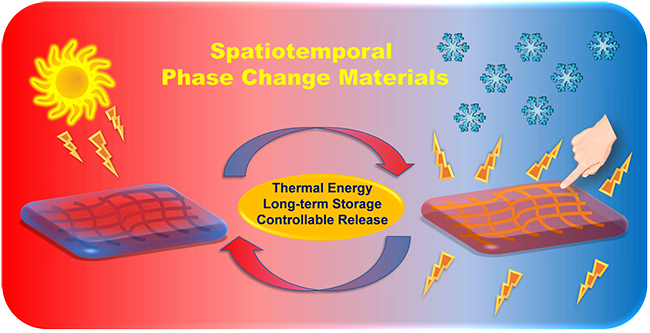A research group led by Prof. SHI Quan from the Dalian Institute of Chemical Physics (DICP) of the Chinese Academy of Sciences (CAS) has proposed a new concept of "Spatiotemporal Phase Change Materials" (STPCMs) long-term storage and controllable release of thermal energy based on phase change materials (PCMs).
This study was published in Journal of Energy Chemistry on Feb.16.
PCMs are promising in the field of thermal energy storage and temperature control. However, PCMs usually release their stored latent heat spontaneously as the temperature below the phase transition temperature, which renders thermal energy storage and release uncontrollable, and thus hinders their practical application.

Schematic diagram of the Spatiotemporal PCMs (Image by DENG Chengxin)
To overcome this issue, the researchers developed erythritol/sodium carboxymethylcellulose/tetrasodium ethylenediaminetetraacetate (ERY/CMC/EDTA-4Na) composite PCMs with novel spatiotemporal thermal energy storage properties. They were defined as spatiotemporal PCMs (STPCMs), and exhibited capacity of long-term storage and controllable release of thermal energy.
They found that the composite PCMs were unable to lose latent heat due to spontaneous crystallization during cooling, but could controllably release thermal energy through cold crystallization during reheating. The cold-crystallization temperature and enthalpy of composite PCMs could be adjusted by proportional addition of EDTA-4Na to the composite.
When the mass fractions of CMC and EDTA-4Na were both 10%, the composite PCMs exhibited optical cold-crystallization temperature of 51.7 °C and enthalpy of 178.1 J/g. The supercooled composite PCMs without latent heat release maintained at room temperature (10–25 °C) for up to more than two months, and subsequently the stored latent heat was controllably released by means of thermal triggering or heterogeneous nucleation.
"Our findings provide novel insights into the design and construction of new PCMs with spatiotemporal performance of thermal energy long-term storage and controllable release, and open a new door for the development of advanced solar thermal utilization techniques on the basis of STPCMs," said Prof. SHI.
The above work was supported by the Joint Fund of Yulin University and Dalian National Laboratory for Clean Energy, and the National Nature Science Foundation of China.